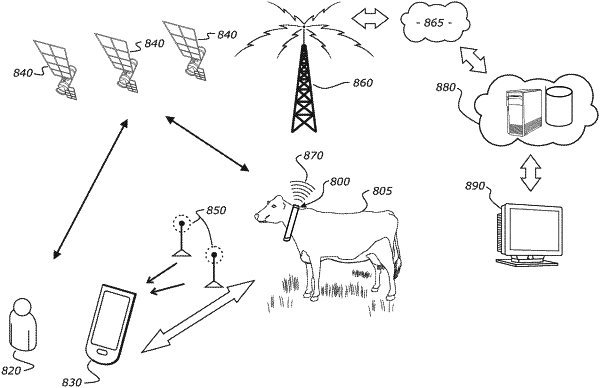| CPC A01K 27/009 (2013.01) [A01K 15/023 (2013.01); A01K 27/001 (2013.01); A01K 29/005 (2013.01); H02S 10/40 (2014.12); H02S 20/30 (2014.12); H02S 40/38 (2014.12); A01K 11/008 (2013.01); H02J 7/35 (2013.01)] | 9 Claims |

|
1. An animal collar for securing around a neck of a livestock animal for allowing a physical response from the livestock animal based on at least one stimulus applied to the livestock animal, the animal collar comprising:
two speakers one located by each ear of the livestock animal configured to apply a first stimulus to the livestock animal by playing sound through one or both speakers that is audible to the livestock animal,
an inertial measurement unit to provide information of the condition of the collar, the information comprising an angular position of the livestock animal's neck and an indication that the movement of the collar is in an up and down direction to indicate that the livestock animal is grazing from a location lower than its normal standing and/or resting condition;
a navigation device to provide location information of the collar;
at least one electrode being adapted to contact the neck of the livestock animal when the collar is secured around the neck of the livestock animal to provide a second stimulus in the form of an electric shock to the livestock animal,
at least one vibrator configured to administer a vibration stimulus that is able to be sensed by the livestock animal, wherein the vibration stimulus is adapted to increase in strength and/or frequency at two or more levels of strength and/or frequency depending on the angular position of the livestock animal's neck,
a transceiver for transmitting at least the location information of the collar and receiving boundary and/or destination information, and
at least one controller configured to provide control signals to the speakers, to the at least one electrode, and to the at least one vibrator by comparing readings from the inertial measurement unit and from the navigation device to the boundary and/or destination information received via the transceiver,
wherein in a first condition the livestock animal is a) free to move around without any administered stimulus and b) allowed to graze, within a field; and the first stimulus is administered via one speaker at a time to keep the animal within the field,
wherein in a second condition when guiding the livestock animal towards a particular position or path outside of the field, the first stimulus is administered through both speakers if the inertial measurement unit in conjunction with the navigation device detects that the livestock animal has stopped and is grazing during guiding of the livestock animal towards the particular position or path, wherein the first stimulus ramps up over a period of time from a minimum level to a maximum level of intensity and continues until it is determined that the livestock animal has stopped grazing and started walking, and when the navigation device detects the livestock animal walking again, the first stimulus ramps down over a period of time to the minimum level of intensity to nothing, and the second stimulus is administered if the livestock animal continues to be stopped and grazing after the first stimulus being administered at the maximum level,
wherein in a third condition when guiding the livestock animal towards the particular position or path, if the inertial measurement unit in conjunction with the navigation device detects that the livestock animal is walking and not grazing and
if the inertial measurement unit detects an abnormal heading, then the first stimulus is administered via one speaker at a time to direct the animal towards the particular position or path;
but if the inertial measurement unit detects a normal heading, then the vibration stimulus is administered to encourage the livestock animal to continue to move forward along the normal heading.
|